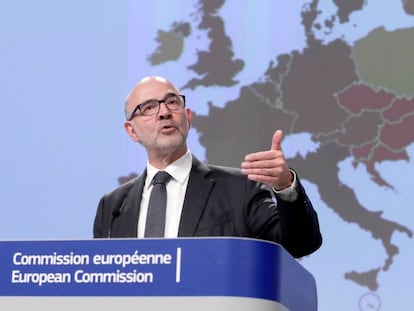Population slowdown is holding back Spain’s economy
A low birth rate and new migration trends pose questions about the country’s ability to generate growth

Imagine two tribes that owe 40 sacks of grain each. Both tribes have 40 members. But as time passes, the first tribe doubles in size to 80 members, while the second one remains stuck at 40. Although both groups have the same amount of debt, the effort of paying it back has been halved for the first one, whose ability to generate wealth is greater.
That is one of the great challenges facing the Spanish economy in a country where population growth is slowing down. An economy can only grow in two ways: either it puts more people and investment to work, or it extracts more out of what it already has through improved productivity.
The Bank of Spain said the economy will grow at 1.25% annually for a few years
During the economic boom of the early 2000s, economic output grew in excess of 3%, yet per capita GDP only progressed at around 1.5%. That is to say that half of GDP growth was due to an influx of people: back then, the population was growing at nearly 2%.
But when the crisis hit, the population stopped growing. Overall GDP and per capita GDP both dropped nearly simultaneously. And when the economy began to recover, both indicators moved up in unison. Although the population was not growing at that point, many unemployed people were returning to the job market, increasing the number of people in employment.
But this trend is starting to run out of steam. Since mid-2019, job creation has been slowing down in line with more sluggish economic output.
Size matters
A few years ago, the Bank of Spain reviewed the economy’s growth potential in the mid and long run, and concluded that it will be around 1.25% annually for a few years. The International Monetary Fund (IMF) holds similar views, based chiefly on Spain’s ageing population and low birth rate.
While immigrant arrivals remain nearly at pre-crisis levels, Spaniards are leaving in greater numbers. And the balance between births and deaths has been negative for four years. A shrinking population also means that monetary and fiscal policy will have less of an effect, says Jesús Fernández-Villaverde, a professor of economics at Penn State University.
Productivity improves a lot right after necessary investments are made. After that, it’s all about innovation
Jesús Fernández-Villaverde, Penn State University
Size matters when it comes to paying off debt, extending pension checks or stimulating investment, notes this expert. The greater the total output, the easier it will be to handle public debt. And the more workers contribute to social security, the easier it will be to pay the pensions: if this bill continues to grow at 8%, GDP growth (inflation included) should follow the same pace if Spain is to make these payments without incurring in deficit. Yet current GDP growth is half of that.
Solutions
One tool for stimulating the economy is raising productivity, a point where Spain has a lot of room for improvement, notes Ángel de la Fuente, head of the applied economics foundation FEDEA.
But Fernández-Villaverde adds that even this is not enough. “How many countries have been able to keep up productivity improvements of 2%? None. Productivity improves a lot right after necessary investments are made. After that, it’s all about innovation.”
Another tool at the government’s disposal is immigration policy. The Fiscal Authority and the IMF are talking about large increases in immigration to help maintain the pension system. But that leads to other questions, says the Penn State professor, such as: “How much immigration will be politically acceptable?”
English version by Susana Urra.
Tu suscripción se está usando en otro dispositivo
¿Quieres añadir otro usuario a tu suscripción?
Si continúas leyendo en este dispositivo, no se podrá leer en el otro.
FlechaTu suscripción se está usando en otro dispositivo y solo puedes acceder a EL PAÍS desde un dispositivo a la vez.
Si quieres compartir tu cuenta, cambia tu suscripción a la modalidad Premium, así podrás añadir otro usuario. Cada uno accederá con su propia cuenta de email, lo que os permitirá personalizar vuestra experiencia en EL PAÍS.
¿Tienes una suscripción de empresa? Accede aquí para contratar más cuentas.
En el caso de no saber quién está usando tu cuenta, te recomendamos cambiar tu contraseña aquí.
Si decides continuar compartiendo tu cuenta, este mensaje se mostrará en tu dispositivo y en el de la otra persona que está usando tu cuenta de forma indefinida, afectando a tu experiencia de lectura. Puedes consultar aquí los términos y condiciones de la suscripción digital.
More information
Archived In
Últimas noticias
Welcome to the post-religion era: The idea of Christianity as the absolute truth has become obsolete
‘I thought you would like it’: The risky sexual practice popularized by TV shows and TikTok
The digitalization of tourism: ‘They promise experiences and gave us the worst possible one’
Mexican peso defies uncertainty with forecasts of a new period of stability in 2026
Most viewed
- Sinaloa Cartel war is taking its toll on Los Chapitos
- Reinhard Genzel, Nobel laureate in physics: ‘One-minute videos will never give you the truth’
- Oona Chaplin: ‘I told James Cameron that I was living in a treehouse and starting a permaculture project with a friend’
- Why the price of coffee has skyrocketed: from Brazilian plantations to specialty coffee houses
- Silver prices are going crazy: This is what’s fueling the rally











































